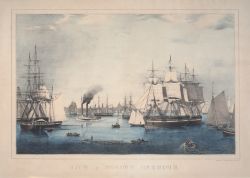loading 
Fitz Henry Lane
HISTORICAL ARCHIVE • CATALOGUE RAISONNÉ • EDUCATIONAL RESOURCE
An online project under the direction of the CAPE ANN MUSEUM
An online project under the direction of the CAPE ANN MUSEUM
Catalog entry
inv. 479
View in Boston Harbour
c. 1836 Colored lithograph on paper 12 15/16 x 19 11/16 in. (32.9 x 50 cm) Sheet: 15 13/16 x 21 7/8 in. (40.3 x 55.7 cm.) Inscribed lower right: T. Moore's Lithography, Boston
Collections:
|
Related Work in the Catalog
Exhibition History
Cape Ann Museum, Gloucester, Massachusetts, Drawn From Nature & on Stone: The Lithographs of Fitz Henry Lane, October 7, 2017–March 4, 2018. [Impression: Boston Athenaeum (inv. 622)].
Published References
Barnhill, Trafton. Drawn from Nature & on Stone: the Lithographs of Fitz Henry Lane. Gloucester, MA: Cape Ann Museum, 2017., fig. 46, text, p. 17, View in Boston Harbour. [Impression: Boston Athenaeum (inv. 622)]. ⇒ includes  text
text
Impression information
Boston Athenaeum (inv. 622)
Inscribed lower right: T. Moore's Lithography, Boston.
Boston Athenaeum
Provenance
Boston Athenaeum

Commentary
This lithograph is very similar to View in Boston Harbour, c.1837 (inv. 605). That print is signed by Lane and dedicated to the Tiger Boat Club. Both were printed by T. Moore's, but this one is not signed by Lane.
The viewing point for this image is one Lane used for most of his Boston Harbor scenes: Governor’s Island, looking west, with the State House the principal landmark on the horizon. The harbor is literally a clutter of vessels of every type, giving the composition a lack of unity and focus. That said, the image becomes an intriguing challenge for ship lovers to scrutinize everything afloat and enjoy the variety of watercraft types, sail handling, and oarsmanship on display.
The number and variety of watercraft under oars is particularly interesting. Front and center is a timber raft – logs and heavy planks lashed together, part of a cargo unloaded by a lumber schooner or gundalow at a distributor’s pier for later delivery to another pier across the harbor. One man on the raft is steering while being towed by a yawl boat under oars. Another yawl boat (right foreground) is being sculled by an oarsman and a single oar. Still another (left foreground) is carrying passengers to a waiting ship. At center middle ground, a yawl boat with a furled spritsail is being rowed in the direction of Boston’s North End.
Small sailing craft include a schooner-rigged boat under full sail (center middle ground), while at far right are a packet sloop under sail and the stern of a pinky – a small schooner first used in Cape Ann’s fishing industries, c.1800.
Full-rigged ships dominate this scene with two under shortened sail in right middle ground; another with all sail furled is at anchor at left. Two topsail schooners can be seen beyond the latter, while two brigs lie at center middle ground with sails furled.
In left middle ground, a coastal steamship is making its departure. This is an early example of the type, with its side-wheels powered by a cross-head engine and two boilers mounted side-by-side.
The large number of vessels in this scene, combining a confusion of sails and rigging, light and shadows, points to Lane’s inexperience in controlling fragmented and strongly contrasting values to create a unified composition. Potential lines of interest are interrupted by scattered areas of light and dark, making a complex scene confusing to anyone not captivated by ships and seamanship.
In the near copy of this image, we will find the same setting and most of the same vessels, but with a very different treatment of sails, water, and patterns of light and dark that work together to unify the composition.
–Erik Ronnberg